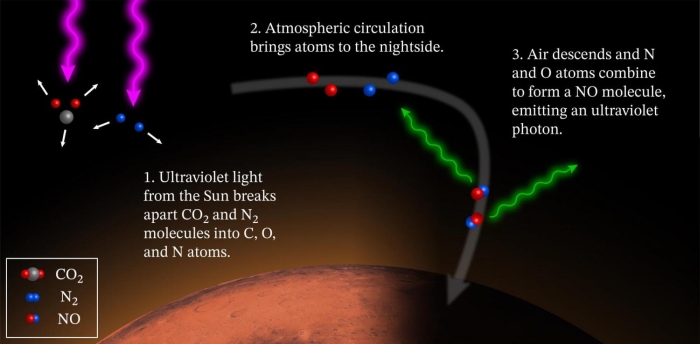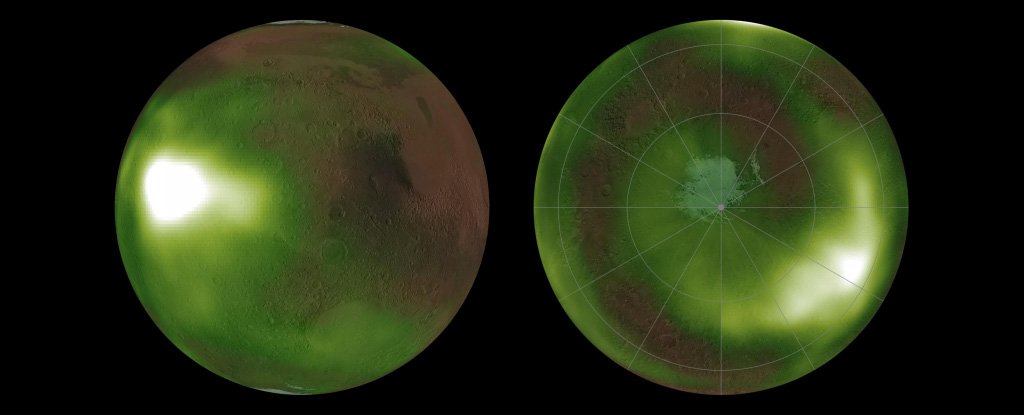Products You May Like
When the Sun sets in a blaze of blue and night falls over the dusty plains of Mars, something weird and wonderful occurs. High up above the surface, the atmosphere begins to glow with an ultraviolet light, sometimes pulsing, as nitrogen and oxygen combine into nitric oxide.
This invisible glow, first revealed by the Mars Orbiter mission in 2005, has now been characterised in detail – and its surprising behaviour is revealing how the Martian atmosphere circulates and changes over the course of the year.
Thin and tenuous as it may be, the atmosphere of Mars is surprisingly complex. Wild winds drive monster storms that can engulf the entire planet. There are seasonal fluctuations in its composition, as well as fluctuations that don’t fit any known processes.
Nightglow, by comparison, isn’t quite as mysterious. In fact, the same phenomenon – nightglow driven by the combination of nitrogen and oxygen, albeit in near-infrared wavelengths – has been observed on Venus, too.
What it can tell us, however, is how Mars’s atmosphere circulates and changes seasonally, in order to help better predict the Red Planet’s crazy weather.
“If we’re going to send people to Mars,” said atmospheric scientist Zachariah Milby of the University of Colorado Boulder’s Laboratory for Atmospheric and Space Physics, “we better understand what’s going on in the atmosphere.”
 (LASP)
(LASP)
The glow occurs when currents high in the Martian atmosphere fall in altitude as temperatures plummet. This altitude is where nitrogen and oxygen atoms (which have been split from CO2, O2, and N2 by sunlight during the day) combine into nitric oxide, emitting small bursts of ultraviolet light; in aggregate, it’s detectable as a nightglow.
The new observations come from NASA’s Mars Atmosphere and Volatile Evolution (MAVEN) orbiter, which has been studying Mars in great detail since 2014.
Five times a day, MAVEN took detailed images of Mars using its Imaging Ultraviolet Spectrograph; with these observations, scientists could track the movements of the ultraviolet glow for the first time.
To the team’s great surprise, the atmosphere pulses three times a night – but only during spring and autumn. During these times, the glow appears around the planet’s middle, growing stronger around the equinoxes.
At other times of the year, the glow is brightest over the polar region in which winter reigns, strongest around the solstice. There, it forms unexpected configurations – waves and spirals.
[embedded content]
“The ultraviolet glow comes mostly from an altitude of about 70 kilometres (44 miles), with the brightest spot about 1,000 kilometres (621 miles) across, and is as bright in the ultraviolet as Earth’s northern lights,” Milby said.
“Unfortunately, the composition of Mars’ atmosphere means that these bright spots emit no light at visible wavelengths that would allow them to be seen by future Mars astronauts. Too bad: the bright patches would intensify overhead every night after sunset, and drift across the sky at 300 kilometres per hour (186 mph).”
And there was another surprise – a persistent bright spot at approximately 0 latitude and 0 longitude, that has yet to be explained. It could be due to the terrain below, or something else that has yet to be discovered.
 The equatorial (left) and polar (right) glow. (LASP)
The equatorial (left) and polar (right) glow. (LASP)
The pulsations in particular reveal a link to waves in the Martian atmosphere. These circle the planet, and their number and speed show that the waves in the middle atmosphere are linked to the daily pattern of solar heating, as well as the shape of the terrain below.
The pulsating spots show a link between the middle atmospheric layer and those above and below – and this relationship is yet another aspect to be explored in future research.
There are still a number of questions to be answered, but the research is a step in the right direction in understanding the complex behaviour of the atmosphere of Mars.
“The behaviour of the Martian atmosphere is every bit as complicated and insightful as that of Earth’s atmosphere,” said lead author and planetary scientist Nick Schneider of CU Boulder.
“We use supercomputers to predict weather on Earth so that you can plan for your vacation or growing crops. The same computer models can be spun up for Mars and all the other planets.”
The research has been published in the Journal of Geophysical Research – Space Physics.
